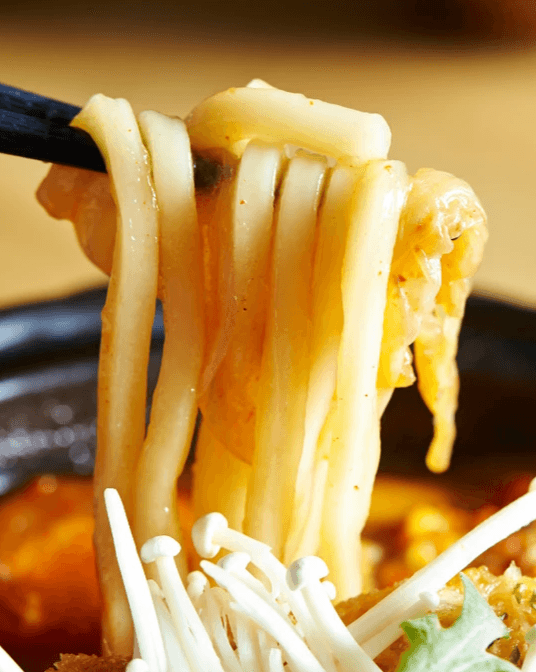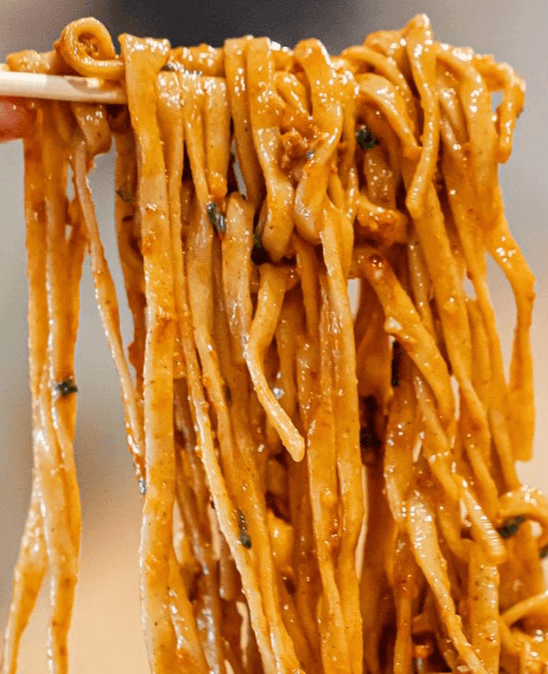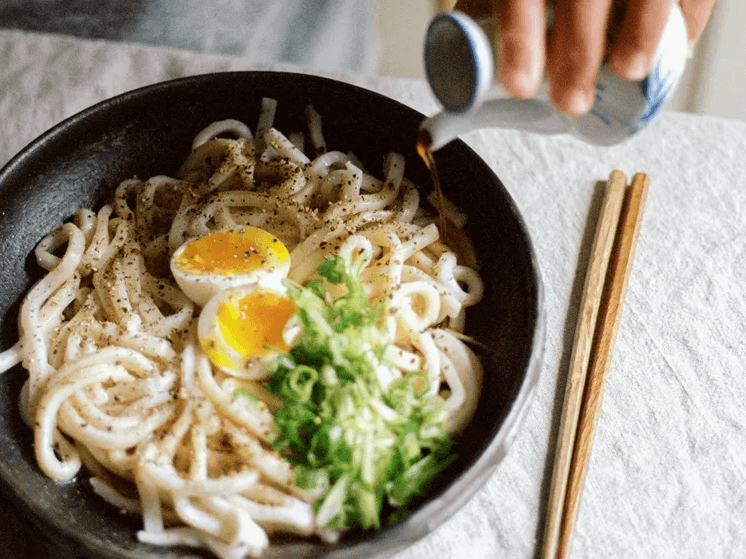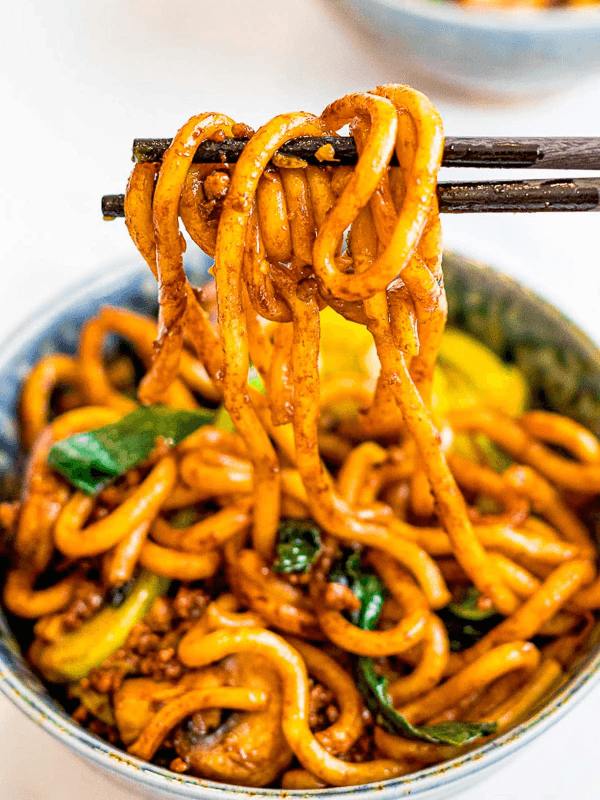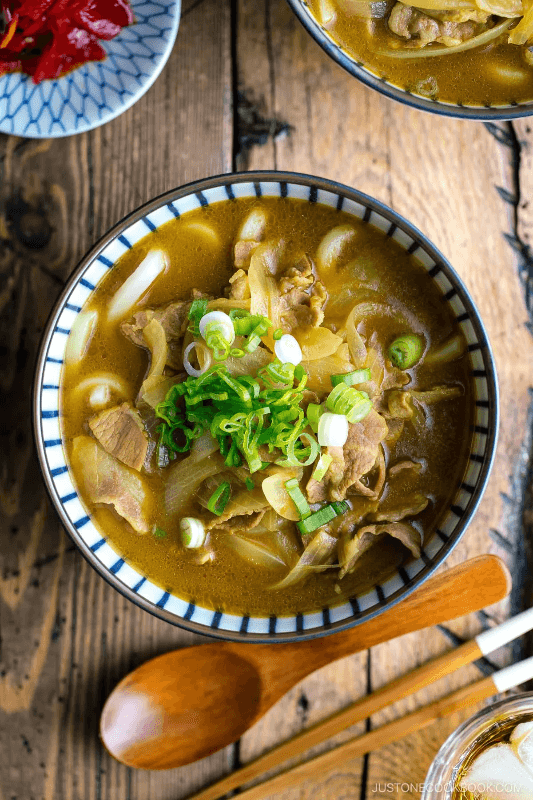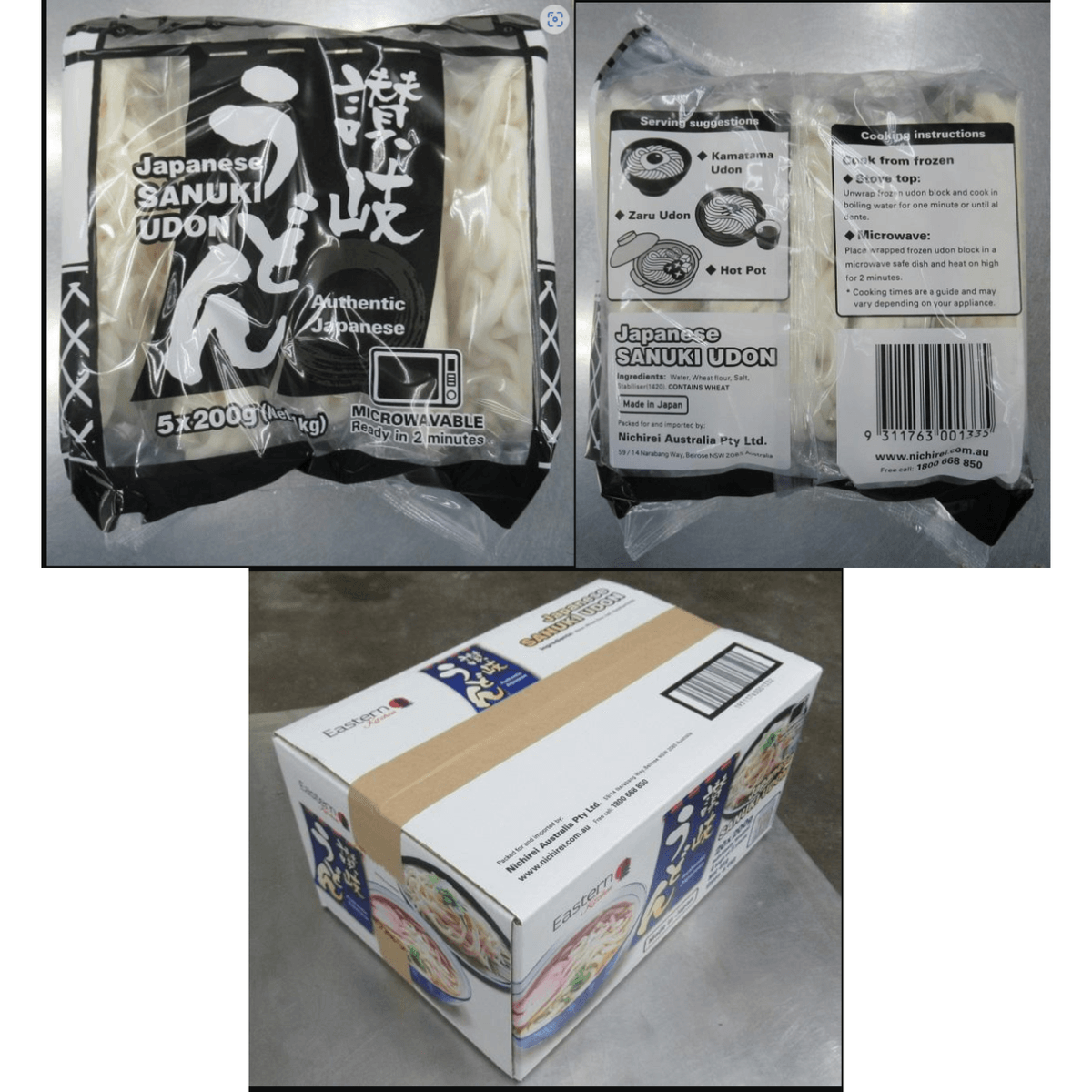
The History and Art of Udon Noodles
Origins and Cultural Significance
Udon noodles are a quintessential part of Japanese cuisine with a history that dates back to the 9th century. Originally introduced to Japan from China, udon underwent a unique transformation, evolving into a distinctively Japanese dish. By the Edo period (1603-1868), udon had become widely popular, particularly in the Sanuki region of Japan, now known as Kagawa Prefecture, where it is famed for its exceptional quality and unique preparation methods.
Symbolism
Udon noodles represent more than just sustenance in Japanese culture; they are a symbol of longevity and strength, owing to their long, unbroken form and hearty texture. They are often consumed during New Year celebrations and other auspicious occasions as a sign of good fortune and health.

Common Preparations
Udon’s versatility is celebrated in several traditional preparations:
• Kake Udon: A simple dish featuring udon noodles in a hot dashi-based broth, topped with thinly sliced scallions.
• Tempura Udon: Udon served with crisp tempura, often shrimp or assorted vegetables, providing a delightful contrast to the chewy noodles.
• Curry Udon: Thick noodles bathed in a rich, spicy curry broth, making for a filling meal.
• Cold Udon: Served chilled with a dipping sauce, ideal for the hot summer months.
Each recipe highlights udon’s ability to blend seamlessly with various ingredients while maintaining its distinct texture and flavor profile.

Why Our Plain
Sanuki Udon Noodles Stand Out
Our plain superior udon noodles, authentically sourced from Japan, offer the perfect canvas for culinary creativity. Crafted using traditional methods, these noodles are distinguished by their:
• Purity: Made with premium wheat flour and pristine water, our udon noodles boast a clean, authentic taste.
• Texture: Achieving the ideal chewiness and elasticity, they hold up beautifully whether served hot in broths or cold with dipping sauces.
• Versatility: The mild flavor of our udon noodles complements a wide range of ingredients and sauces, making them an ideal base for both traditional and innovative dishes.
Our udon noodles invite you to express your culinary artistry, allowing flavors to shine through in each dish. Whether you’re simmering a delicate broth or crafting a bold, spicy sauce, our noodles provide a foundation that elevates every ingredient, making each meal not just a dish, but an experience.
Rediscover the joy of cooking with our superior udon noodles—where your hands bring the flavor to life.
Cooking Instructions
Option 1: Stove top
- Unwrap frozen udon block and cook in boiling water for one minute or until indente.
Option 2: Microwave
- Place wrapped frozen udon block in a microwave safe dish on high for 2 minutes.
* Cooking times are a guide and may vary depending on your appliance.
Recipes
Udon noodles are super versatile and can be dressed up in so many tasty ways. Whether you’re in the mood for something warm and comforting or cool and refreshing, we’ve got a recipe for you. Here are a few of our top picks to get creative with these awesome noodles. Dive in and start cooking up some deliciousness!
Life-Changing Udon with Soft-Boiled Egg, Hot Soy, and Black Pepper
By Hetty McKinnon, Food & Wine
Ingredients:
4 large eggs
2 cups vegetable stock
3 tablespoons tamari or soy sauce
2 teaspoons mirin
1 3/4 pounds fresh, vacuum-sealed, or frozen udon noodles (such as Twin Marquis)
6 tablespoons unsalted butter (3 ounces), cubed
4 scallions, finely chopped (about 2/3 cup)
Black pepper
1 tablespoon sesame oil
Fine sea salt
Directions:
1. Fill a small saucepan with water; bring to a boil over high. Lower eggs into water, and cook 6 minutes. Transfer eggs to a large bowl of ice water. Let cool 5 minutes. Drain and peel eggs, and set aside.
2. Bring a large saucepan of salted water to a boil over high. While water comes to a boil, stir together vegetable stock, tamari, and mirin in a small saucepan; cook over low, stirring occasionally, until hot, about 8 minutes. Add noodles to boiling water, and cook according to package directions for al dente. Drain noodles, and divide evenly among 4 bowls.
3. Divide butter evenly among bowls; pour hot soy sauce mixture evenly over bowls. Halve eggs lengthwise, and top each bowl with 2 egg halves. Sprinkle evenly with scallions, and scatter a generous amount of black pepper over noodles. Drizzle evenly with sesame oil, and garnish with sea salt.
Yaki Udon
By Jamie of Drive Me Hungry
Ingredients:
2 packets udon noodles total 13 oz vacuum packed noodles; see Note 1
2½ cups stir fry vegetables chopped (I used mushrooms, bok choy, onions)
2 stalks scallions cut 2 inches long
½ lb ground meat beef, chicken, turkey, pork, shrimp
1 Tablespoon avocado oil
Yaki Udon Noodle Sauce
2½ Tablespoons dark soy sauce see Note 2
2 Tablespoons oyster sauce see Note 3
1 Tablespoon mirin see Note 4
2 teaspoons brown sugar
½ teaspoon rice wine vinegar
Instructions:
1. Sauce: Mix all the ingredients for the sauce in a small bowl and set aside.2½ Tablespoons dark soy sauce,2 Tablespoons oyster sauce,1 Tablespoon mirin,2 teaspoons brown sugar,½ teaspoon rice wine vinegar
2. Cook the Udon Noodles
Remove your udon noodles from its package and add it to a pot of boiling water. Frozen udon noodles can be added directly to the pot of boiling water. Stir gently until your udon noodles are separated and pliable. This should take 1 - 2 minutes. They come precooked so avoid overcooking them as they can get too soft.2 packets udon noodles. Rinse and drain your noodles under cold water. If not using right away, drizzle on a little bit of oil to keep them from sticking.
3. Stir Fry
Heat your pan over high heat and add the oil. Add in the ground meat and stir fry until almost cooked. Add the vegetables and stir fry until meat is fully cooked and vegetables are soft. Next add in the noodles, sauce, and scallions. Add less sauce if you prefer. Continue stir frying for about 3 minutes or until well combined. Serve immediately. (2½ cups stir fry vegetables,½ lb ground meat,1 Tablespoon avocado oil,2 stalks scallions)
Curry Udon
By Namiko Chen of Just One Cook Book
Ingredients:
½ onion (5.7 oz, 162 g)
2 green onions/scallions (for garnish)
1 Tbsp neutral oil
6 oz thinly sliced pork loin (cut into bite-sized pieces; you can substitute your choice of protein)
1 Tbsp sake
3 cups dashi (Japanese soup stock) (use standard Awase Dashi, dashi packet or powder, or Vegan Dashi)
2 cubes Japanese curry roux (2 oz, 50 g; or make homemade Japanese Curry Roux)
2 tsp soy sauce
2 servings udon noodles (1.1 lb, 500 g frozen or parboiled udon noodles; 6.3 oz, 180 g dry udon noodles)
Instructions:
1. Gather all the ingredients. Break the boxed roux into cubes and use 2 cubes Japanese curry roux (keep the leftovers in an airtight container and store in the refrigerator/freezer for 1–3 months). Prepare 3 cups dashi (Japanese soup stock) using your preferred method.
2. Thinly slice ½ onion and 2 green onions/scallions. Set aside the green onions for garnish.
3. Preheat a medium pot or Dutch oven (I used a 2.75 QT Staub) over medium heat. When the pot is hot, add 1 Tbsp neutral oil. Next, add the onion slices. Sauté the onion slices for 2–3 minutes.
4. Add 6 oz thinly sliced pork loin that you‘ve cut into bite-sized pieces. Cook the meat until it‘s barely pink.
5. Add 1 Tbsp sake. Add the dashi to the pot and cover with the lid. Reduce the heat to medium low and cook for 5 minutes.
Note: When simmering, skim off the scum and fat from the stock with a fine-mesh skimmer and continue to cook.
6. Start boiling a large pot of water for the udon.
7. After 5 minutes of simmering the stock and meat, turn off the heat. Next, put a cube of curry roux in a ladleful of hot stock.
With chopsticks or a spoon, dissolve the roux cube completely in the ladle, then release it to the soup. Repeat with the next cube.
Tip: You don‘t want to eat a chunk of undissolved curry roux, so take your time to dissolve it completely.
8. Add 2 tsps soy sauce and mix well. Turn off the heat and cover with the lid to keep it warm.
9. When the water is boiling, cook 2 servings of udon noodles according to the package instructions (for this Sanuki udon, I heated the frozen noodles in boiling water for 1 minute).
10. To serve, drain the noodles and divide into two bowls. Pour the curry soup over the udon noodles. Top with the green onions and serve immediately.
11. To store, keep the leftover curry soup in a glass airtight container and store it in the refrigerator for up to 3 days and in the freezer for a month. Defrost in the refrigerator for 24 hours and reheat in a pot. I recommend cooking the udon noodles just before serving.

Sanuki Udon Specifications
Ingredients: Wheat (24.93%), Salt (0.31%), Modified Starch (1069%), Water (64.07%)
Country of Origin: Product of Japan
Features: Authentic Japanese Sanuki Udon, 20 servings per case, chewy texture, smooth throat feel
Calories: 258 per serving
Sodium: 0.13 per serving
Carbs: 23.9 per serving
Protein: 5.2 per serving
Shelf life: 18 months
Storage Condition: -18℃
Pack Style: 200 g. x 5 pieces/4 bags
Inner Bag Dimensions W x L x H (mm): 165 x 150 x 100
Inner Bag Weight (grams): 1016
Inner Bag Material: PP, PE
Outer Case W x L x H (mm): 346 x 226 x 167
Outer Case Weight (grams): 4368
Outer Case Material: Cardboard
Copyright © 2025 Noon International. All rights reserved.

